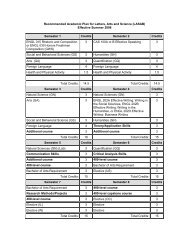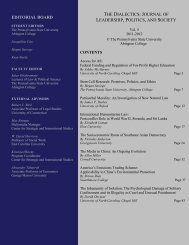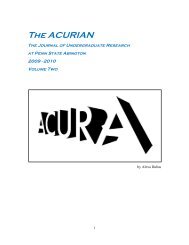Vol. III - Penn State Abington
Vol. III - Penn State Abington
Vol. III - Penn State Abington
Create successful ePaper yourself
Turn your PDF publications into a flip-book with our unique Google optimized e-Paper software.
transactions have become increasingly complicated and diversified. So it may be unrealistic to<br />
disclose all the details of CRAs’ rating procedures, but there is one thing that can be done: the<br />
underlying data supplied to CRAs from the issuers or arrangers should be regulated and exposed<br />
to the public, so any CRA can examine the accuracy of its competitors’ reports. And, obviously,<br />
the SEC has been aware of this option (U.S. Securities and Exchange Commission, 2008:13).<br />
2) The Pay Model<br />
Some have argued that the issuer pay model has to be altered to an investor pay model in<br />
order to solve the conflicts of interest problem (Strier, 2008:533-553). However, the investor pay<br />
model will bring in another problem—a “free ride”. In fact this is one of the reasons the big three<br />
moved gradually to depending on issuers rather than investors in the 1970s. This creates the<br />
danger that information bought by some investors may be spread to others who don’t subscribe<br />
to the CRAs’ service (Richardson, 2009). That would make it difficult for CRAs to make enough<br />
profits to sustain their high-quality staff, which would harm the initiative and capacity of CRAs.<br />
If a shift from an issuers pay model to an investor pay model will induce another problem<br />
in the course of trying to solve a problem, it would not be an optimal solution.<br />
3) Reducing regulators’ reliance on CRAs<br />
According to the SEC report, privilege extended to the securities which are rated highly<br />
by NRSROs should be reduced (Gullo, 2009). In this way, investors will depend more on their<br />
own assessments rather than NRSROs’ ratings.<br />
Although this is the right direction to reform the NRSRO mechanism, it has to be noticed<br />
that it is almost impossible to eliminate all these requirements from all the systems, because they<br />
involve too many regulations and rules. And, in fact, in some regulations, their guidelines are<br />
necessary to regulate the financial market. It would be costly for regulators to keep watching the<br />
market respectively to make these guidelines.<br />
So, the key point here is not to remove all these regulations and rules from all systems,<br />
but that the regulation of the NRSRO needs to match the power they gain from these rules.<br />
4) Facilitating New Entrants<br />
Another way to offset the negative effect of conflicts of interest is to increase competition<br />
in the credit rating market, especially among NRSRO. In the reform act of 2006, the SEC defines<br />
the conditions of registration for NRSRO, including participating in the credit rating business for<br />
at least three years, and the wide recognition of its ratings by financial institutions, issuers,<br />
insurance companies (Credit Rating Agency Reform Act, 2006). After this act was put in<br />
practice, ten CRAs were accepted as NRSROs by the end of 2008 (Hunt, 2008). In this way, the<br />
monopoly status of the big three can be gradually weakened.<br />
In addition to clarifying NRSRO conditions, the SEC can examine the qualification for<br />
all NRSRO based on a set of criteria after a period of time. Most importantly, the SEC can<br />
establish a record center for historical ratings of all NRSRO. In this way, NRSRO will be forced<br />
to act more cautiously because being classed as an “NRSRO” provides privilege in the credit<br />
rating market and can bring great benefit to a business.<br />
THE DIALECTICS ▲ 2009<br />
www.abington.psu.edu/dialectics<br />
36







